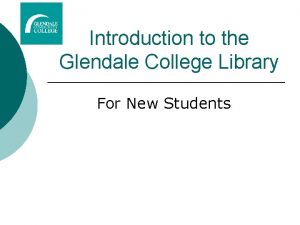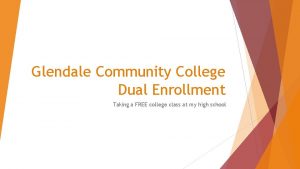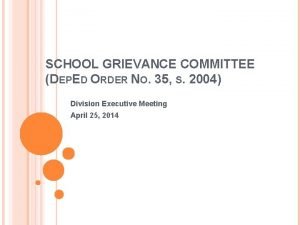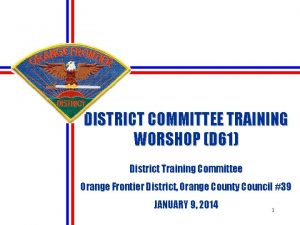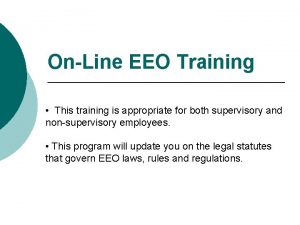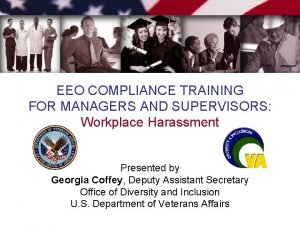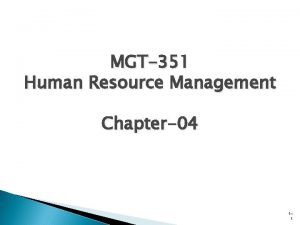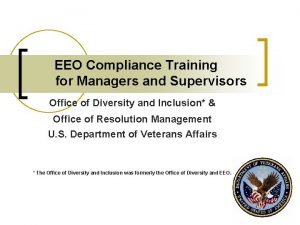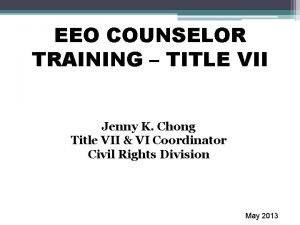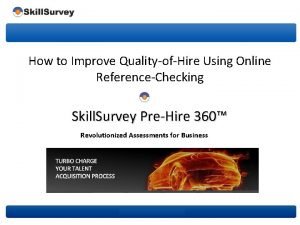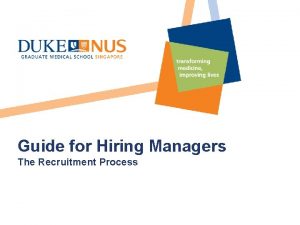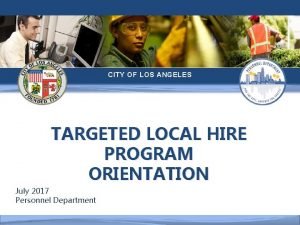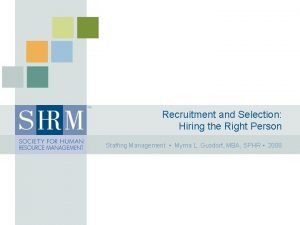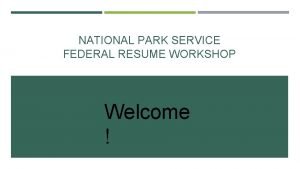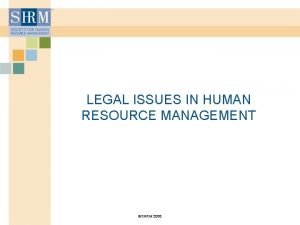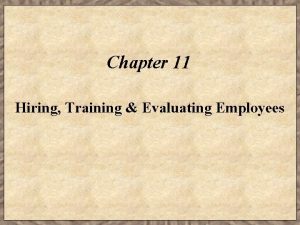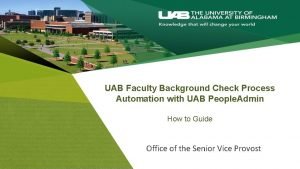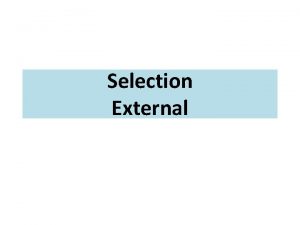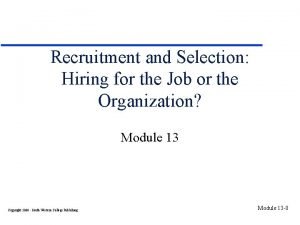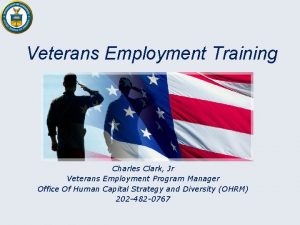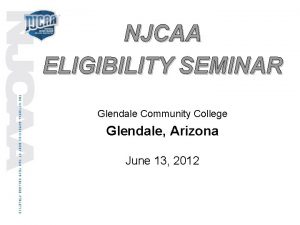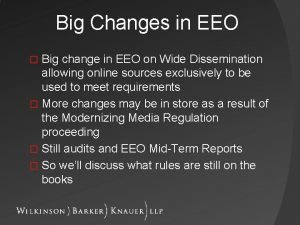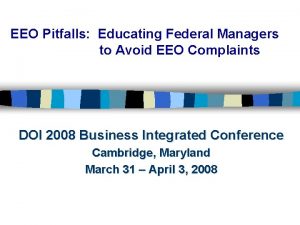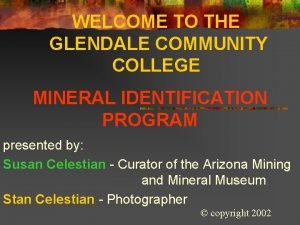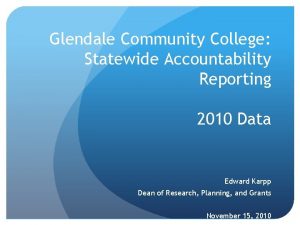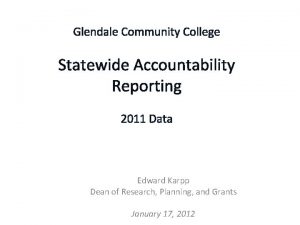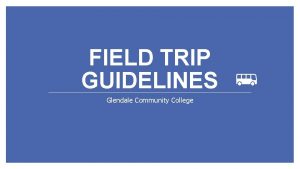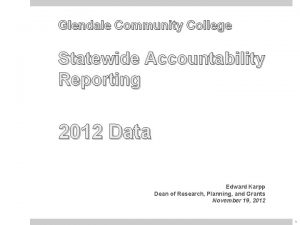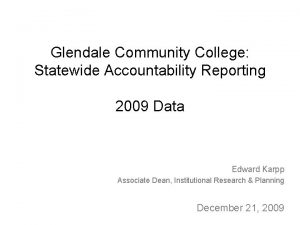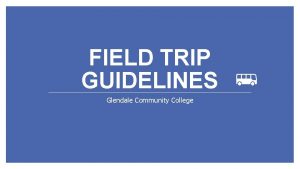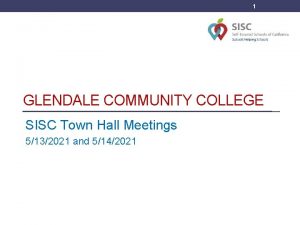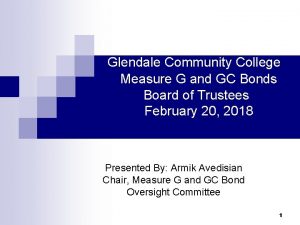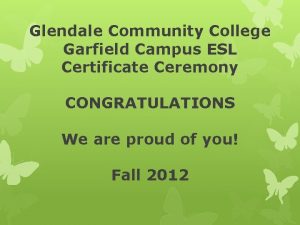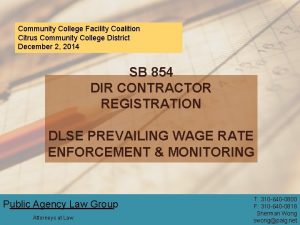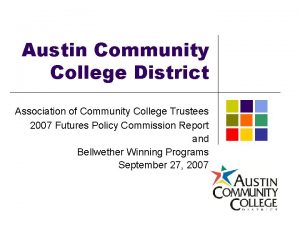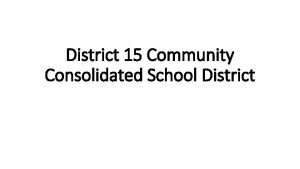1 Glendale Community College District Hiring Committee EEO


































- Slides: 34

1 Glendale Community College District Hiring Committee EEO Training

2 What We’ll Cover u Concepts of Equal Employment Opportunity, Diversity and Bias u Confidentiality u Roles and Responsibilities u Application Screening u Preparing for Interviews u Deliberations Process u Candidates with Disabilities

3 Equal Employment Opportunity and Diversity

4 What is Equal Employment Opportunity? “Equal Employment Opportunity” (EEO) means freedom from discrimination on the basis of sex, color, religion, national origin, disability and age. EEO rights are guaranteed by federal and state fair employment laws and are enforced by the Equal Employment Opportunity Commission (EEOC) and its state counterparts, California’s Department of Fair Employment and Housing and the Office of Civil Rights.

5 Equal Employment Opportunity GCC Board Policy 3410 Glendale Community College District is committed to providing an equal opportunity for admissions, student financing, student support programs and activities, and employment regardless of race, religious creed, color, age, sexual orientation, national origin, ancestry, marital status, medical condition, or disability in accordance with federal, state, and local regulations. Education Code 87100 A work force that is continually responsive to the needs of a diverse student population may be achieved by ensuring that all persons receive an equal opportunity to compete for employment and promotion within the community college districts and by eliminating barriers to equal employment opportunity.

6 Commitment to Diversity Board Policy 7100 The District is committed to employing administrators, faculty, and staff members who are dedicated to student success. The District recognizes that diversity in the academic environment fosters cultural awareness, promotes mutual understanding and respect, and provides suitable role models for all students. The District is committed to hiring and staff development processes that support both equal opportunity and diversity, and provide equal consideration for all candidates as required in federal and state law.

7 Equal Employment Opportunity To ensure equal employment opportunity: 1. Be aware of and confront biases and conflicts of interest 2. Remove any artificial barriers in the application and employment processes 3. Ensure MQs and desirable qualifications are bona fide and job related 4. Ensure all application screening criteria are job related and derive from information contained in the job announcement 5. All screening criteria and interview questions are set before application screening begins 6. Ensure all interview questions and activities are relevant and job-related 7. Maintain integrity of the search process 8. Maintain 100% confidentiality throughout the process

8 Our Goal To forward the best qualified pool of finalists to the President and the Board of Trustees. These candidates will be selected without regard to race, ethnicity, gender identity, religion, political beliefs, disability status, and/or sexual orientation.

9 Roles and Responsibilities

10 Responsibilities of the Committee Chair u Maintain compliance with all district policies and procedures governing the hiring process u Review committee responsibilities with members and respond to questions and concerns u Diligently monitor the overall process for fairness u Review application screening criteria and interview questions to ensure they are appropriate and job related. u Be available and prepared to discuss candidates and committee recommendations with Superintendent/ President (or designee).

11 Responsibilities of Committee Members u Actively participate in the process u Develop application screening criteria and interview questions u Evaluate and rate candidates u Interview candidates u Make recommendation of finalists u Be fair and consistent in applying the evaluation criteria u Notify the EEO representative if you believe there has been a violation of district policy, an unfair practice or bias in the process, or if you have a conflict of interest. u Maintain confidentiality before, during, and after the process has been completed!

12 Responsibilities of the EEO Representative u Ensure that district board policies and administrative regulations are adhered to throughout the process. u Monitor the hiring process and established guidelines for compliance u Has the authority to halt the process when and if appropriate. u Reports allegations of non-compliance to the District’s EEO Officer.

13 Bias and conflicts of interest

14 Bias and Conflicts of Interest A bias is an assumption, tendency or belief that can prevent us from making an objective decision about a candidate. A large body of research suggests that each one of us holds implicit biases that can impact our judgment. Biases, whether positive or negative, conscious or unconscious, are shaped by our experiences, culture, and lifestyles. This include campus culture. The most common forms of bias found in hiring decisions are: 1) Internal Candidate, 2) Confirmation Bias, 3) Personal Appearance, 4) Expectation and 5) Intuition.

15 Bias and Conflicts of Interest u The best way to avoid unconscious bias is to make sure that all candidates are interviewed, evaluated and considered equally. u Do not allow your scoring to be overly influenced by a particular trait (either positive or negative) (i. e. age, race, looks, tattoos, college attended) u Committee members must disclose personal feelings (positive or negative) that would prevent you from being fair or impartial. u Not revealing a conflict of interest could lead to removal from the hiring committee. It could also lead to a complaint of unfair hiring practice.

16 Internal or Other Known Candidates u Committee members must approach an internal or otherwise known candidate in the same way you approach an external candidate. u Committee members may not fill in any omissions in any Applicant’s application materials or interview answers with information you may independently know about the candidate, (e. g. bad behavior, or known projects, research or grants that the candidate did not include).

17 Confidentiality

18 Confidentiality u The hiring process is a confidential process. It is critical that all committee members maintain the highest degree of confidentiality in order to preserve the integrity of the process. u We have promised confidentiality to all applicants. Breaching that confidentiality could impact their current employment. u Failure to maintain confidentiality may result in removal from the committee and disciplinary action.

19 Confidentiality u The confidentiality requirement extends throughout this process and after the process is completed. In other words – forever. u Examples of breaches of confidential include: o Unofficially contacting college colleagues for information about applicants o Answering questions from curious colleagues regarding the pool or the process o Divulging information about applicants or committee discussions at any time before, during, or after the process.

20 Application Screening

21 Application Screening u Application screening is done online. If this is a problem for anyone let the committee chair know. u Each committee member will score the applicants based only on the job related criteria established by the committee. u Scoring is an individual activity. Committee members should not be discussing the candidates and/or the scoring of candidates outside the group committee meetings and deliberations.

22 Application Screening u The committee will convene to rank the candidates and determine which candidates to invite for interview. u The committee should look for a “natural” break (the largest point gaps between candidates) u in scores There are no predetermined number of candidates to interview u There are no alternates u Remember to maintain confidentiality!

23 Preparing for Interviews

24 Preparing for Interviews Remember… u Candidates are interviewing us as much as we are interviewing them. u The interview process can be intimidating. u Be warm and engaging. u Candidates should leave feeling that the process was handled professionally and that they were treated with respect.

25 Preparing for Interviews The committee should take time to collectively: u Review the job announcement u Assign questions to committee members u Discuss general framework for successful responses to individual questions u Prior to each interview the committee should briefly review the candidate’s application

26 Guidelines for Interviews u Be fair, consistent, and impartial in your assessment and scoring. u Make notes that will help you in recalling why you scored the candidate the way you did. u Do not draw on your interview sheets or write down non- relevant information. Your notes can be subpoenaed! u Be professional, courteous, and attentive at all times recognizing that you represent the college. u Ask the same interview questions of all candidates. u Follow up questions are allowed but be careful here.

27 Deliberations

28 Deliberations u All discussions about candidates should be held until it is time for deliberations. u Discussions must be limited to the submitted application materials and the answers given in the interview. u If a committee member has outside knowledge of the candidate that they feel is important, they should discuss this with the committee chair. The committee chair will determine what information is appropriate to share with the committee.

29 Deliberations u No committee member should attempt to intimidate or sway another committee member to change their score in order to move a candidate up or down in the rankings. u It is ok for committee members to discuss the merits and challenges of candidates which may result in other committee members changing their scores. u It is ok to change scores based on committee deliberations. Committee members should note their changes along with the reason for the change.

30 Deliberations u There should be no pre-determined number of candidates who will be forwarded in the process. u A decision on which candidates to forward and how many candidates to forward should be made based on objective scoring and ranking of applicants and determination of a natural break in scores.

31 Candidates With Disabilities

32 Candidates with Disabilities u Reasonable accommodations must be made to assist candidates with disabilities throughout the application and interviewing process. u Discussion of an applicant’s disability is not appropriate during the interview process. Any discussion about an applicant’s disability and how it may impact their ability to perform the essential duties of the position will happen after the job offer is made. u The disability may not enter into the decision to forward a candidate in the hiring process.

33 Contact Information If you become aware of acts that violate confidentiality, fairness, or equal opportunity, please immediately notify the EEO Representative and Committee Chair.

34 Questions?
 Glendale college library
Glendale college library Nursing school glendale
Nursing school glendale Glendale community college rn program
Glendale community college rn program Glendale community college dual enrollment
Glendale community college dual enrollment Glendale community college nursing prerequisites
Glendale community college nursing prerequisites Sample of school grievance committee
Sample of school grievance committee District committee member
District committee member Online eeo training
Online eeo training Eeo preaward clearance
Eeo preaward clearance Eeo training for managers
Eeo training for managers What is job specification in hrm
What is job specification in hrm Eeo 1 report remote employees
Eeo 1 report remote employees Eeo compliance training for managers and supervisors
Eeo compliance training for managers and supervisors Eeoc south africa
Eeoc south africa Eeo counselor training
Eeo counselor training Recruitment vs selection
Recruitment vs selection Skill survey healthcare hiring
Skill survey healthcare hiring Recruitment process flowchart
Recruitment process flowchart City of los angeles targeted local hire
City of los angeles targeted local hire Targeted local hire
Targeted local hire Geico hiring process 2020
Geico hiring process 2020 Selection in staffing
Selection in staffing Campus hiring
Campus hiring Public land corps hiring authority usajobs
Public land corps hiring authority usajobs Negligent hiring in hrm
Negligent hiring in hrm Hiring training and evaluating employees
Hiring training and evaluating employees Ameren gas laborer
Ameren gas laborer Uab adminsystem
Uab adminsystem Initial assessment methods for hiring
Initial assessment methods for hiring Difference between hiring and recruitment
Difference between hiring and recruitment Travel histology jobs
Travel histology jobs 5 cfr 213,3102(u)
5 cfr 213,3102(u) Targeted local hire program agency referral form
Targeted local hire program agency referral form Glenwood community schools
Glenwood community schools Johnstoncsd
Johnstoncsd
